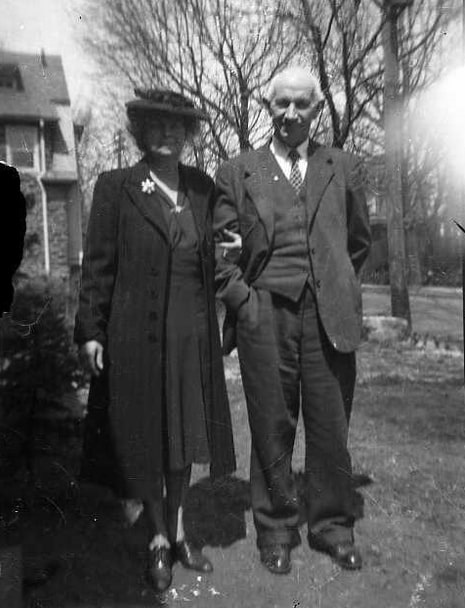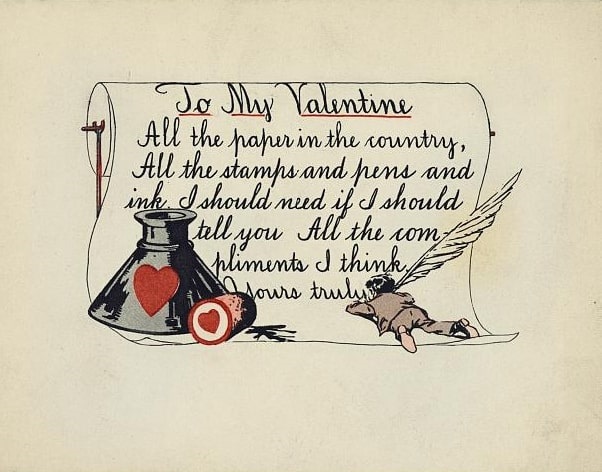Introduction: In this article – to help celebrate Valentine’s Day – Katie Rebecca Garner relates the love story of her 2nd great-grandparents. Katie specializes in U.S. research for family history, enjoys writing and researching, and is developing curricula for teaching children genealogy.
Many couples celebrate their love on Valentine’s Day, while single people look for some other love to celebrate. Whether you’re single or coupled, Valentine’s Day is a good day to celebrate your ancestors’ love, because their love led to your existence. You can do so by learning their love stories.
The first step in learning of your ancestors’ romance is to find their marriage record. The marriage record for my 2nd great-grandparents, Joseph McElhinney and Mary Louise Kearney, states that they were married 17 June 1913 in Philadelphia.

Their marriage license gives their birth information and occupations. Joseph was a chauffeur. He was born 26 February 1889 in Ireland. Mary Louise was born 10 August 1891 in Camden, New Jersey.
Learning background information about the families can help flesh out the love story. You can do this by looking for new records or by examining records already listed for them. In the case of my great-great-grandparents, many sources were already attached to each of them in FamilySearch Family Tree.
Joseph McElhinney arrived in the U.S. in 1909 and naturalized in 1917. (1) The 1910 census shows Mary as a young woman living with her family in Cheltenham, Pennsylvania, which is an hour’s journey from Philadelphia on modern public transit. She did not have an occupation. This census shows her father had been born in Ireland and her mother in England. (2) A further examination of the family tree shows that Mary’s maternal grandparents had been born in Ireland. The 1920 census shows Joseph and Mary McElhinney living in Philadelphia with their children. Joseph was a chauffeur. (3)
In other cases, records might show the families of the bride and groom being in each other’s FAN clubs (Friends, Associates, Neighbors). The bride’s and groom’s households may be near each other on census records. The fathers or uncles may have bought and sold land from each other. The families’ lands may have been adjacent to each other. The bride’s and groom’s families may have attended the same church congregation. If the families were immigrants, they may have known each other in the old country, or traveled to the U.S. together.

Sometimes the love story, or other stories, are passed down through family lore. The family lore around Joseph McElhinney and Mary Louise Kearney states they worked for the same rich family. He was their chauffeur, and she was a cook.
Details on records can only go so far in inferring a story. It is also helpful to know historical context. Learning historical context can range from a quick Google search to extensive study of books and newspapers, including those found in GenealogyBank’s Historical Newspaper Archives. The book Marriage, a History: From Obedience to Intimacy or How Love Conquered Marriage by Stephanie Coontz details marriage practices from ancient times to modern days.
According to Coontz, the late nineteenth century and early twentieth century was a time when the Western world was transitioning from courting to dating. In courting, the couple visits at the girl’s home under the supervision of her family. Beginning in the late nineteenth century, young, single women began leaving their homes to work, putting them in a situation where they could get to know young men without parental supervision. Considering this and what the records show about the Kearney’s and Joseph McElhinney, Mary most likely moved from her home to Philadelphia to work. She met Joseph at her job in the city.
It is also important to note Mary’s and Joseph’s Irish heritage. Joseph was an Irish immigrant and Mary was a child of Irish immigrant parents. During this time, it was very common for first- and second-generation Irish immigrants to marry other Irishmen. (4) Additionally, Irish immigrants in America faced discrimination, which may have been fed by their own collective attitude that they were exiled from their homeland. (5) This attitude of exile may have encouraged Irish immigrants to choose other Irish immigrants for marriage partners.
Even though Mary’s mother was born in England, she would have considered herself an Irish woman having been raised by Irish parents. Mary would have grown up hearing stories of the homeland she never saw. It makes sense she would have been attracted to an Irish immigrant. According to family lore, Joseph had been forced to emigrate, so it also makes sense that he’d seek out an Irish wife.
While details of Mary Louise Kearney and Joseph McElhinney’s courtship were not included in the family lore passed down, records of their lives and marriage survive. Using these and knowledge of history helped add flesh to their love story. You can do the same with your family.
This Valentine’s Day, celebrate your ancestors’ love by learning their love stories: refer to family stories where available, look for records, and learn the historical context.
Explore over 330 years of newspapers and historical records in GenealogyBank. Discover your family story! Start a 7-Day Free Trial
_________________
(1) “Pennsylvania, Eastern District Petitions for Naturalization, 1795-1931,” database with images, FamilySearch (https://familysearch.org/ark:/61903/1:1:QGJQ-3DNQ: accessed 8 March 2021), Joseph McElhinney, 17 Aug. 1917; citing Naturalization, Pennsylvania, United States, NARA microfilm publication M1522 (Washington, D.C.: National Archives and Records Administration, n.d.); FHL microfilm.
(2) 1910 U.S. census, Montgomery County, Pennsylvania, population schedule, Cheltenham, sheet 1B, dwelling 21, Mary Kearney in household of John Kearney; digital image, FamilySearch (https://familysearch.org: accessed 7 February 2023), citing NARA microfilm publication T624.
(3) 1920 U.S. census, Philadelphia County, Pennsylvania, population schedule, Philadelphia Ward 22, sheet 8A, dwelling 136, family 141, Joseph McElhinney household; digital image, FamilySearch (https://familysearch.org: accessed 7 February 2023), citing NARA microfilm publication T625.
(4) ‘Ties That Bind: Ethnic and Religious Factors in the Marriage Choices of Irish,” American Catholics on the Dakota Frontier on JSTOR, accessed 6 February 2023,
(5) “Fighting for Their Lives: Why the Marginalized Irish from the 1840s-1910 Dominated American Prizefighting,” Virtual Commons – Bridgewater State University, accessed 6 February 2023, https://vc.bridgew.edu/cgi/viewcontent.cgi?article=1419&context=honors_proj
